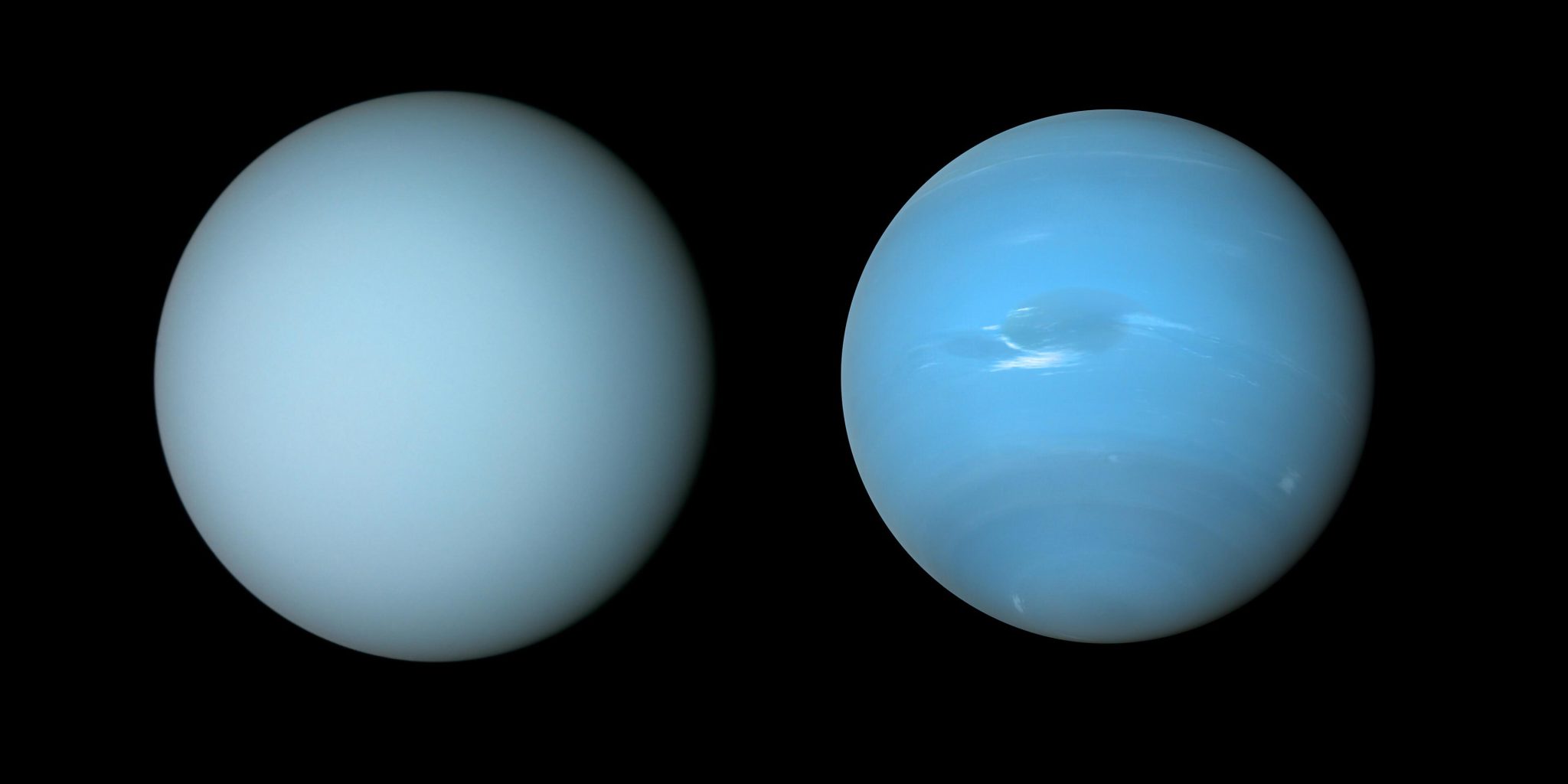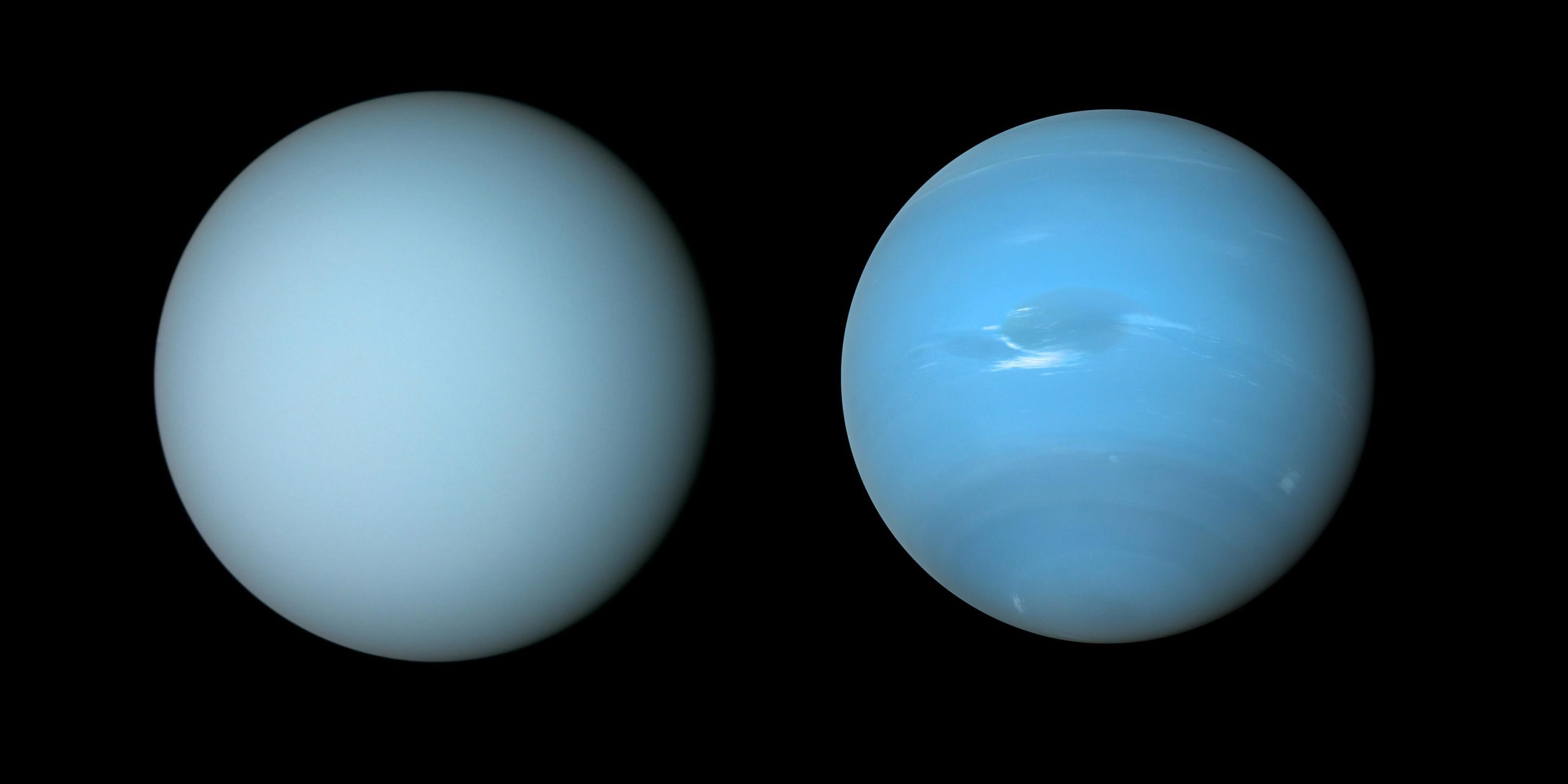
Tàu vũ trụ Voyager 2 của NASA đã chụp được những hình ảnh này của Sao Thiên Vương (trái) và Hải Vương Tinh (phải) trong các hành tinh bay lượn vào những năm 1980. Nhà cung cấp hình ảnh: NASA / JPL-Caltech / B.Johnson
Các quan sát từ Đài quan sát Gemini và các kính thiên văn khác cho thấy khói mù quá mức[{” attribute=””>Uranus makes it paler than Neptune.
Astronomers may now understand why the similar planets Uranus and Neptune have distinctive hues. Researchers constructed a single atmospheric model that matches observations of both planets using observations from the Gemini North telescope, the NASA Infrared Telescope Facility, and the Hubble Space Telescope. The model reveals that excess haze on Uranus accumulates in the planet’s stagnant, sluggish atmosphere, giving it a lighter hue than Neptune.
Các hành tinh Sao Hải Vương và Sao Thiên Vương có rất nhiều điểm chung – chúng có khối lượng, kích thước và thành phần khí quyển tương tự nhau – nhưng hình dáng của chúng lại khác nhau rõ rệt. Ở bước sóng nhìn thấy được, Sao Hải Vương có màu xanh hơn trong khi Sao Thiên Vương có màu lục lam nhạt hơn. Các nhà thiên văn học hiện đã có lời giải thích tại sao hai hành tinh lại có màu sắc khác nhau như vậy.
Nghiên cứu mới chỉ ra rằng lớp mây mù tập trung được tìm thấy trên cả hai hành tinh dày hơn trên Sao Thiên Vương so với lớp tương tự trên Sao Hải Vương và “làm trắng” vẻ ngoài của Sao Thiên Vương nhiều hơn trên Sao Hải Vương.[1] Nếu không có sương mù môi trường xung quanh Từ Sao Hải Vương và Sao Thiên Vương, cả hai sẽ có màu xanh lam gần như bằng nhau.[2]
Kết luận này đến từ một mô hình[3] mà một nhóm quốc tế dẫn đầu bởi Patrick Irwin, giáo sư vật lý hành tinh tại Đại học Oxford, đã phát triển để mô tả các lớp sol khí trong bầu khí quyển của Sao Hải Vương và Sao Thiên Vương.[4] Các cuộc điều tra trước đây về tầng trên của các hành tinh này chỉ tập trung vào sự xuất hiện của khí quyển ở các bước sóng cụ thể. Tuy nhiên, mô hình mới này, được tạo thành từ nhiều lớp khí quyển, phù hợp với các quan sát từ cả hai hành tinh trên một dải bước sóng rộng. Mô hình mới cũng bao gồm các hạt mờ bên trong các lớp sâu hơn mà trước đây được cho là chỉ chứa các đám mây metan và băng hydro sunfua.

Biểu đồ này cho thấy ba lớp sol khí trong bầu khí quyển của Sao Thiên Vương và Sao Hải Vương, được thiết kế bởi một nhóm các nhà khoa học do Patrick Irwin đứng đầu. Máy đo độ cao trên đồ thị biểu thị áp suất trên 10 bar.
Lớp sâu nhất (lớp aerosol-1) dày và bao gồm hỗn hợp băng hydro sunfua và các hạt từ sự tương tác của bầu khí quyển hành tinh với ánh sáng mặt trời.
Lớp chính ảnh hưởng đến màu sắc là lớp ở giữa, là một lớp các hạt sương mù (trong bài báo gọi là lớp aerosol-2) trên Sao Thiên Vương dày hơn trên Sao Hải Vương. Nhóm nghiên cứu nghi ngờ rằng trên cả hai hành tinh, băng metan ngưng tụ trên các hạt trong lớp này, kéo các hạt vào sâu hơn trong khí quyển khi tuyết metan rơi xuống. Do bầu khí quyển của Sao Hải Vương hoạt động mạnh và hỗn loạn hơn so với của Sao Thiên Vương, nên nhóm nghiên cứu tin rằng bầu khí quyển của Sao Hải Vương hiệu quả hơn trong việc chuyển các hạt mêtan vào lớp mây mù và tạo ra tuyết đó. Điều này giúp loại bỏ nhiều mây mù hơn và giữ cho lớp sương mù của Sao Hải Vương mỏng hơn so với trên Sao Thiên Vương, có nghĩa là màu xanh lam của Sao Hải Vương dường như mạnh hơn.
Bên trên cả hai lớp là một lớp sương mù kéo dài (lớp sol khí 3) tương tự như lớp bên dưới nhưng mỏng manh hơn. Trên Sao Hải Vương, các hạt băng lớn mêtan cũng hình thành bên trên lớp này.
Nhà cung cấp hình ảnh: Đài quan sát quốc tế Gemini / NOIRLab / NSF / AURA, J. da Silva / NASA / JPL-Caltech / B.Johnson
Irwin, tác giả chính của bài báo trình bày phát hiện này trên Tạp chí Nghiên cứu Địa vật lý: Các hành tinh giải thích: “Đây là mô hình đầu tiên phù hợp đồng bộ với các quan sát phản xạ ánh sáng mặt trời từ tia cực tím đến tia hồng ngoại gần”. “Ông ấy cũng là người đầu tiên giải thích sự khác biệt về màu sắc có thể nhìn thấy giữa Sao Thiên Vương và Sao Hải Vương.”
Mô hình của nhóm nghiên cứu bao gồm ba lớp sol khí ở các độ cao khác nhau.[5] Lớp chính ảnh hưởng đến màu sắc là lớp giữa, là một lớp các hạt sương mù (được gọi trong bài báo là lớp aerosol-2) dày hơn Sao Thiên Vương Sau đó sao Hải vương. Nhóm nghiên cứu nghi ngờ rằng trên cả hai hành tinh, băng metan ngưng tụ trên các hạt trong lớp này, kéo các hạt vào sâu hơn trong khí quyển khi tuyết metan rơi xuống. Do bầu khí quyển của Sao Hải Vương hoạt động mạnh và hỗn loạn hơn so với của Sao Thiên Vương, nên nhóm nghiên cứu tin rằng bầu khí quyển của Sao Hải Vương hiệu quả hơn trong việc chuyển các hạt mêtan vào lớp mây mù và tạo ra tuyết đó. Điều này giúp loại bỏ nhiều mây mù hơn và giữ cho lớp sương mù của Sao Hải Vương mỏng hơn so với trên Sao Thiên Vương, có nghĩa là màu xanh lam của Sao Hải Vương dường như mạnh hơn.
Mike Wong, một nhà thiên văn học tại[{” attribute=””>University of California, Berkeley, and a member of the team behind this result. “Explaining the difference in color between Uranus and Neptune was an unexpected bonus!”
To create this model, Irwin’s team analyzed a set of observations of the planets encompassing ultraviolet, visible, and near-infrared wavelengths (from 0.3 to 2.5 micrometers) taken with the Near-Infrared Integral Field Spectrometer (NIFS) on the Gemini North telescope near the summit of Maunakea in Hawai‘i — which is part of the international Gemini Observatory, a Program of NSF’s NOIRLab — as well as archival data from the NASA Infrared Telescope Facility, also located in Hawai‘i, and the NASA/ESA Hubble Space Telescope.
The NIFS instrument on Gemini North was particularly important to this result as it is able to provide spectra — measurements of how bright an object is at different wavelengths — for every point in its field of view. This provided the team with detailed measurements of how reflective both planets’ atmospheres are across both the full disk of the planet and across a range of near-infrared wavelengths.
“The Gemini observatories continue to deliver new insights into the nature of our planetary neighbors,” said Martin Still, Gemini Program Officer at the National Science Foundation. “In this experiment, Gemini North provided a component within a suite of ground- and space-based facilities critical to the detection and characterization of atmospheric hazes.”
The model also helps explain the dark spots that are occasionally visible on Neptune and less commonly detected on Uranus. While astronomers were already aware of the presence of dark spots in the atmospheres of both planets, they didn’t know which aerosol layer was causing these dark spots or why the aerosols at those layers were less reflective. The team’s research sheds light on these questions by showing that a darkening of the deepest layer of their model would produce dark spots similar to those seen on Neptune and perhaps Uranus.
Notes
- This whitening effect is similar to how clouds in exoplanet atmospheres dull or ‘flatten’ features in the spectra of exoplanets.
- The red colors of the sunlight scattered from the haze and air molecules are more absorbed by methane molecules in the atmosphere of the planets. This process — referred to as Rayleigh scattering — is what makes skies blue here on Earth (though in Earth’s atmosphere sunlight is mostly scattered by nitrogen molecules rather than hydrogen molecules). Rayleigh scattering occurs predominantly at shorter, bluer wavelengths.
- An aerosol is a suspension of fine droplets or particles in a gas. Common examples on Earth include mist, soot, smoke, and fog. On Neptune and Uranus, particles produced by sunlight interacting with elements in the atmosphere (photochemical reactions) are responsible for aerosol hazes in these planets’ atmospheres.
- A scientific model is a computational tool used by scientists to test predictions about a phenomena that would be impossible to do in the real world.
- The deepest layer (referred to in the paper as the Aerosol-1 layer) is thick and is composed of a mixture of hydrogen sulfide ice and particles produced by the interaction of the planets’ atmospheres with sunlight. The top layer is an extended layer of haze (the Aerosol-3 layer) similar to the middle layer but more tenuous. On Neptune, large methane ice particles also form above this layer.
More information
This research was presented in the paper “Hazy blue worlds: A holistic aerosol model for Uranus and Neptune, including Dark Spots” to appear in the Journal of Geophysical Research: Planets.
The team is composed of P.G.J. Irwin (Department of Physics, University of Oxford, UK), N.A. Teanby (School of Earth Sciences, University of Bristol, UK), L.N. Fletcher (School of Physics & Astronomy, University of Leicester, UK), D. Toledo (Instituto Nacional de Tecnica Aeroespacial, Spain), G.S. Orton (Jet Propulsion Laboratory, California Institute of Technology, USA), M.H. Wong (Center for Integrative Planetary Science, University of California, Berkeley, USA), M.T. Roman (School of Physics & Astronomy, University of Leicester, UK), S. Perez-Hoyos (University of the Basque Country, Spain), A. James (Department of Physics, University of Oxford, UK), J. Dobinson (Department of Physics, University of Oxford, UK).
NSF’s NOIRLab (National Optical-Infrared Astronomy Research Laboratory), the US center for ground-based optical-infrared astronomy, operates the international Gemini Observatory (a facility of NSF, NRC–Canada, ANID–Chile, MCTIC–Brazil, MINCyT–Argentina, and KASI–Republic of Korea), Kitt Peak National Observatory (KPNO), Cerro Tololo Inter-American Observatory (CTIO), the Community Science and Data Center (CSDC), and Vera C. Rubin Observatory (operated in cooperation with the Department of Energy’s SLAC National Accelerator Laboratory). It is managed by the Association of Universities for Research in Astronomy (AURA) under a cooperative agreement with NSF and is headquartered in Tucson, Arizona. The astronomical community is honored to have the opportunity to conduct astronomical research on Iolkam Du’ag (Kitt Peak) in Arizona, on Maunakea in Hawai‘i, and on Cerro Tololo and Cerro Pachón in Chile. We recognize and acknowledge the very significant cultural role and reverence that these sites have for the Tohono O’odham Nation, the Native Hawaiian community, and the local communities in Chile, respectively.
“Nhà phân tích. Con mọt sách thịt xông khói đáng yêu. Doanh nhân. Nhà văn tận tâm. Ninja rượu từng đoạt giải thưởng. Một độc giả quyến rũ một cách tinh tế.”
